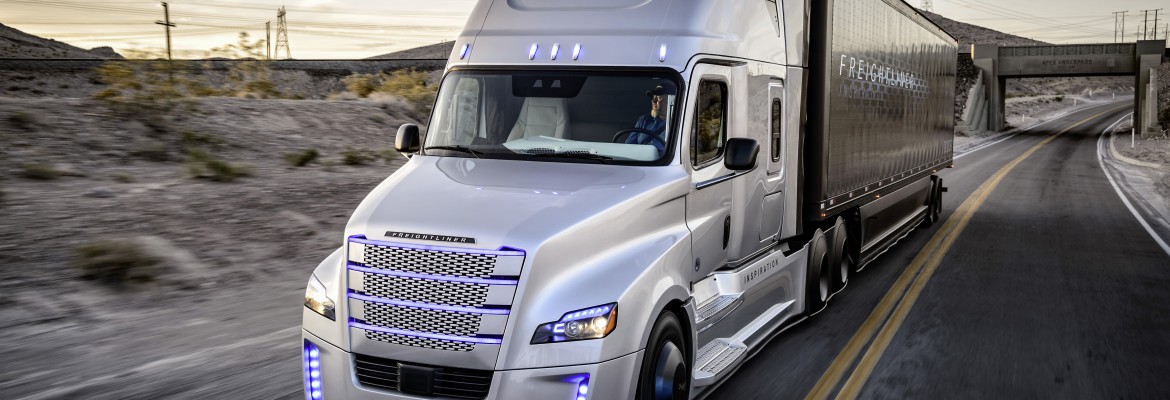Coming Soon to a Depot Near You
Well… It sort of depends on who’s doing the talking. Maybe yes or maybe no, self-driving trucks are just around the next corner.
By Kenneth E. Seaton
For a type of vehicle that’s not yet fully operational, it’s known by many names. Self-driving, autonomous, driverless, automated and/or connected vehicles. Nonetheless it doesn’t really matter what it’s called.

What does matter is that the driver is usually just along for the ride. And, with the constant advancements in Artificial Intelligence (AI) vehicle designers are determined to deliver a vehicle from here to there without the assistance or need of a human driver.
AI-equipped vehicles use a complex combination of on-board cameras, sensors, software and radar to operate and control self-driving vehicles. The end goal is to successfully navigate between destinations without a human – one is usually sitting behind the wheel with their hands ready to assist – driver. Vehicles use GPS to continually track its location and to enable it to navigate successfully to its destination.
To be considered as fully autonomous, vehicles need to be capable of traveling without human aid to a predetermined point. This must also be accomplished via roadways that have not been adapted for its usage. Self-driving vehicles must have the capacity to continually adapt to their surroundings, be able to avoid any potential obstacles and to park without any human intervention.
Of-course, this is a simplified description of what makes a vehicle a self-driving vehicle.
Suffice it to say that the vehicle’s AI system takes in a tremendous amount of data, analyzes it, identifies recognizable patterns and then forms predictions as to what will or will not happen next. All this is done in nano seconds! The more selfdriving vehicles are driven, the more the AI system learns.
Some of the major & minor drivers in the push for autonomous vehicles
For a very long-time man has dreamed about riding around in some type of autonomous vehicle. Realistically, it wasn’t until companies like Google, Uber and Apple began working on their own versions, that people started to take selfdriving vehicles seriously. General Motors, Tesla, Ford, Daimler, Waymo, Volkswagen and Audi are also some of the other major companies developing autonomous vehicles.
Work is being accomplished at a breakneck pace in the race towards operational self-driving trucks. And a growing number of trucking industry leaders are beginning to view autonomous vehicles in a more positive light. They are now seeing them as a way to; help with offsetting the looming driver shortage, increase productivity by better controlling costs, operate more fuel-efficient vehicles, etc.
As the trucking industry moves ever closer to the day-to-day use of autonomous vehicles, more and more companies are joining the field. Well-known truck vehicle producers like Daimler, Tesla and Volvo, are being seriously challenged by new start-ups like: Einride, Waymo, TuSimple, Embrake, Ike, plus others.
The United States Postal Service (USPS) recently began testing self-driving trucks to transport mail and it is partnering with a California based start-up company named TuSimple on the project. Two of TuSimple’s self-driving vehicles will transport mail between distribution centers in the southwestern cities of Phoenix, Arizona and Dallas, Texas.
The trucks are expected to make five round trips between the cities. With each trip consisting of about 3,300 kilometers. The goal of the testing is to see if; the self-driving technology can reduce transportation times, lower expenses and improve over all road safety. If successful, the Postal Service could deploy the trucks permanently to move mail between major U.S. population centers.
FedEx could be considered as major/ minor player in the autonomous vehicle field. In February it unveiled its “SameDay Bot” autonomous delivery device. The company called the Bot a “cuttingedge delivery solution to meet the rapidly changing needs of consumers.” FedEx expects that the device will allow retailers to make same-day and last-mile deliveries to their customers.
With the bot, retailers will be able to accept orders from nearby customers and deliver them by bot directly to the customers’ homes or businesses the same day. FedEx is collaborating with companies such as AutoZone, Lowe’s, Pizza Hut, Target, Walgreens and Walmart to help assess retailers’ autonomous delivery needs.
Not to be left behind, Walmart is also conducting a pilot project that is testing the user ability of autonomous vehicles. Announcing in June that it will be test running a self-driving van to move customer orders between two of its stores. The vehicles will cover a 3-kilometer route in its hometown of Bentonville, Arkansas.
Tech start-up Gatik AI – which specializes in B2B short-haul logistics in autonomous vehicles and has teams in Palo Alto & Toronto – is partnering with Walmart for this venture. Gatik AI will run three modified Ford Transit Connect vans up to 10 times a day, seven days a week. The vans will only operate during daylight hours and will carry human safety operators for backup. Gait’s goal is to help cut human labour from what may be considered mundane tasks, such as transportation orders between stores.
Canadian connections to autonomous vehicles
In January, Ontario’s Ministry of Transportation (MTO) continued its commitment to the future of driverless vehicles by expanding its 10-year pilot project to test and evaluate the use of automated vehicles (AVs) on Ontario roadways. This pilot program was for evaluating cooperative truck platooning (Platoon Pilot).
A cooperative truck platoon means two or more commercial motor vehicles use an advanced driver assistance system and vehicle-to-vehicle communication system to travel in a convoy. The vehicles must steer, accelerate and brake cooperatively and synchronously. The Ministry is allowing a limited pilot of truck platoons to demonstrate their potential, compatibility with existing road users and infrastructure and confirm their overall safety.
This is not an entirely new concept, as truck platooning testing, was also conducted last fall on Canadian roads. FPInnovations, in collaboration with Transport Canada, carried out testing on a highway between Blainville and Trois-Rivières, Que. The goal was to explore if technology developed by Auburn University – which was designed to work on highways – could also work on Canadian forest and rural roads.
Other testing goals were to examine ways and means of utilizing the new technology on autonomous logging trucks to, help reduce fuel consumption, address driver shortages and improve business efficiency. The testing demonstrated that the technology worked but also highlighted that further work was needed to improve communications between the various devices.
In February, The Canadian Press reported that Blackberry received $40 million in federal funding to help develop technologies that would make cars safer, more connected to cyberspace and eventually, capable of driving themselves. BlackBerry currently has its QNX software installed in tens of millions of cars, guiding systems related to driver assistance, hands-free features and entertainment consoles.
The one-time smartphone company leader is using the federal money for software development of the next generation of autonomous vehicles as well as skills training for its workers. The company is putting $300 million of its own money into the initiative, expected to create 800 jobs over the next decade at BlackBerry’s campus in the Ottawa suburb of Kanata, as well as support 300 existing jobs there.
Will truckers be out of a job?
According to Statistics Canada, truck driving provides nearly two per cent of all Canadian jobs, more than three per cent of jobs for men. There is still a shortage of drivers, but as autonomous trucks flood into the market, demand for those workers will mostly plunge.

However, some trucking industry experts believe differently. They feel that with the introduction of self-driving trucks, there may actually be more jobs available to drivers. Some self-driving truck designers and manufacturers are building vehicles with the intention of having back up drivers sitting in the cabs. They think that too many things can possibly go awry, especially at hi-way speeds, to not have a human on-board ready to take over if required.
Drivers may also be needed to drive the vehicle to a certain point i.e. an AI adapted hi-way and then switch the vehicle over to autonomous mode. Once the vehicle reaches the end of the adapted hi-way, a driver may then be required to drive it to its destination point. Drivers could also take over when driving along country roads and for loading and offloading purposes.
Of-course, in the end, monetary incentives may prove to be too irresistible to the trucking industry. They understand that drivers can only drive for specified amounts of time. They must take in food and by necessity, have rest and sleep breaks. Human drivers have also been known to make bad choices, suffer brain freezes and sometimes become confused when placed in highly stressful situations.
Driver down-time negatively impacts 14 autoatlantic.com n november 2019 Truckers Corner on a vehicle’s bottom line. Contrast this against a fully self-driving vehicle which is able to operate – theoretically – for 24 hours a day and seven days a week. Financial experts are predicting that by only operating autonomous vehicles, a trucking company will lower its operating costs, double overall efficiency and resultantly, greatly increase its profit margins.
Self-driving trucks will potentially solve many of the trucking industries ongoing day-to-day operational challenges. While autonomous vehicle testing continues moving relentlessly forward, it’s noteworthy that there’s a great difference between self-driving trucks and self-driving cars. There are several diverse operational issues separating the two types of vehicles.
Size is one major issue. Trucks are a lot larger than cars and bringing the vehicle to a full stop, take so much longer. Also, with greater size comes greater maneuverability challenges. An increased number of sensors and cameras are required, and placement could prove problematic. Positioning them on top of a higher vehicle may open them up to the increasing likelihood of some form of impairment. Inclement weather, being struck by low hanging objects or becoming overloaded by the sheer volume of data intake, are just several possibilities.
The ability to be able to safely guide a large self-driving truck around accident scenes, dodging pedestrians and through demanding inner-city settings will also require a complex number of sensors, radars and cameras. The more AI there is operating onboard a vehicle, the greater the prospect for incidents or accidents.
However, these could all very well prove to be mote points. It’s more than likely that seasoned government officials and politicians – possibly influenced by public opinion – may vote to take the trucking industry down another road. It might occur to them, that a large number of potential voters may still believe that having a driver onboard and ready to take over the wheel in-case of emergency, will make the hi-ways and roads safer.
Understanding automation levels
The Canadian Council of Motor Transport Administrators (CCMTA), Transport Canada and Ontario’s Ministry of Transportation have adopted the following terminology developed by The Society of Automotive Engineers (SAE) International Universal Classification System to define automation levels for motor vehicles:
Level 0 – No Automation: No automated features.
Level 1 – Driver Assistance: Intelligent features add layer of safety and comfort. A human driver is required for all critical functions.
Level 2 – Partial Automation: At least two automated tasks are managed by the vehicle, but the driver must remain engaged with the driving task.
Level 3 – Conditional Automation: The vehicle becomes a co-pilot. The vehicle manages most safety-critical driving functions but the driver must be ready to take control of the vehicle at all times.
Level 4 – High Automation: The vehicle is capable of performing all driving functions under certain conditions. The driver may have the option to control the vehicle.
Level 5 – Full Automation: Vehicle is capable of being completely driverless. Full-time automated driving in all conditions without need for a human driver.


